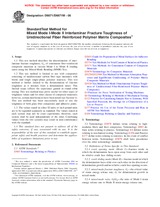We need your consent to use the individual data so that you can see information about your interests, among other things. Click "OK" to give your consent.
ASTM D6671/D6671M-06
Standard Test Method for Mixed Mode I-Mode II Interlaminar Fracture Toughness of Unidirectional Fiber Reinforced Polymer Matrix Composites
STANDARD published on 1.3.2006
The information about the standard:
Designation standards: ASTM D6671/D6671M-06
Note: WITHDRAWN
Publication date standards: 1.3.2006
SKU: NS-36096
The number of pages: 14
Approximate weight : 42 g (0.09 lbs)
Country: American technical standard
Category: Technical standards ASTM
Annotation of standard text ASTM D6671/D6671M-06 :
Keywords:
composite materials, delamination, interlaminar fracture toughness, mixed-mode bending, Mode I-Mode II, ICS Number Code 19.060 (Mechanical testing), 83.120 (Reinforced plastics)
Additional information
| 1. Scope | ||||||||||||||||||||||||
|
1.1 This test method describes the determination of interlaminar fracture toughness, Gc, of continuous fiber-reinforced composite materials at various Mode I to Mode II loading ratios using the Mixed-Mode Bending (MMB) Test. 1.2 This test method is limited to use with composites consisting of unidirectional carbon fiber tape laminates with brittle and tough single-phase polymer matrices. This test method is further limited to the determination of fracture toughness as it initiates from a delamination insert. This limited scope reflects the experience gained in round robin testing. This test method may prove useful for other types of toughness values and for other classes of composite materials; however, certain interferences have been noted (see Section ). This test method has been successfully used to test the toughness of both glass fiber composites and adhesive joints. 1.3 The values stated in either SI units or inch-pound units are to be regarded separately as standard. The values stated in each system may not be exact equivalents; therefore, each system shall be used independently of the other. Combining values from the two systems may result in non-conformance with the standard. This standard does not purport to address all of the safety concerns, if any, associated with its use. It is the responsibility of the user of this standard to establish appropriate safety and health practices and determine the applicability of regulatory limitations prior to use. |
||||||||||||||||||||||||
| 2. Referenced Documents | ||||||||||||||||||||||||
|



 Cookies
Cookies
